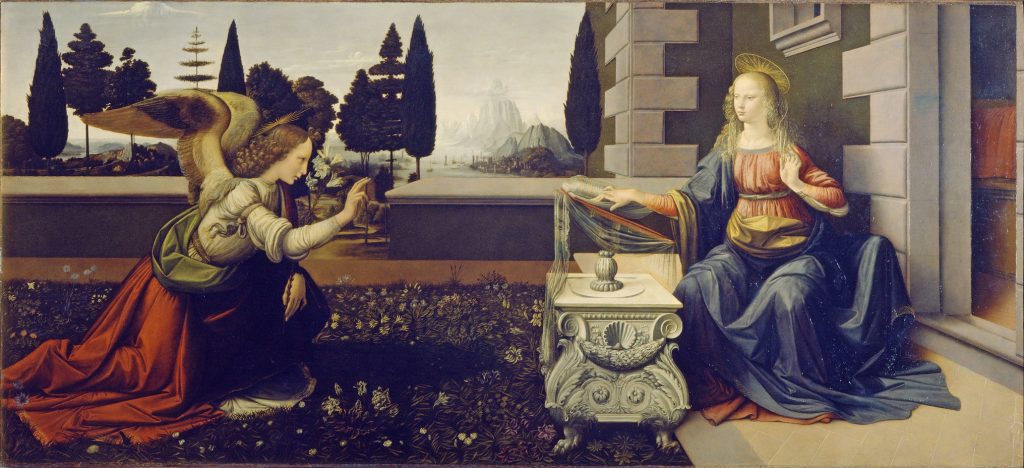THE ANNUNCIATION – LEONARDO DA VINCI
As indicated by its name, Leonardo da Vinci’s painting has the theme of an announcement. One of the major topics in Christian belief and a prominent theme in art history, the Annunciation, depicts the scene where Virgin Mary receives the news from archangel Gabriel that she is pregnant.
The Annunciation paintings focus on the moment when Gabriel appears in front of Virgin Mary, who devoted herself to religion, and thus, is piously reading/praying in her room. According to the Bible of Luke, Gabriel becomes visible, salutes Mary and tells her that she is favoured by God, she is blessed among all women and she would conceive and give birth to a child, Jesus Christ, Son of God.
The Annunciation themed paintings appear with profoundly similar elements and symbols all throughout the history of art. Leonardo also used these elements and symbols as expected:
1) Mary is generally portrayed sitting or kneeling with a book in her hand, front or side of her in Annunciation themed paintings. This book refers to the Hebrew Bible (Tanakh), which forms the basis for the Old Testament (the New Testament part of the Christian Bible will be formed after Jesus Christ). In this painting, Mary is depicted sitting on a chair, reading a large book on the platform in front of her. Surprised by the appearance of Gabriel, she raises her left hand.
2) Annunciation scenes are generally depicted in Mary’s bedroom, this time Leonardo chose to use the garden in front of Mary’s bedroom as the setting. The door on the very right of the painting opens to Mary’s bedroom and shows the viewer a glimpse of her bed inside. This narrow view provides a sense of depth to the painting towards the right part of the painting.
3) Gabriel on the left is shown to kneel before Mary to convey her God’s good news. Gabriel is an easily recognisable angel in Renaissance paintings with its large and colourful wings. Like all angels, Gabriel is shown sexless here, with an image that remains between a young woman and an adolescent man.
4) The branch of white lilies in Gabriel’s hand symbolizes Mary’s purity and virginity. This symbol of lily is used almost in all of the annunciation depictions, whether in Gabriel’s hand or standing aside in a vase.
5) Another main element of annunciation themed paintings is the third element of the Holy Trinity of Christianity: the Holy Spirit. Holy Spirit is always represented by a white dove in Renaissance art. Jesus was conceived by the Holy Spirit rising above Mary. Thus, the presence of a white dove flying towards/over Mary is pretty common in these paintings. Nevertheless, Leonardo da Vinci preferred to eliminate this symbol in his painting.
Considering the real event happening in Jerusalem, we expect the background to be a desert view. However, the artist painted the greens hills and forests of the Toscana region of Italy, which was well known to him. This view, filled with trees and hills, extends further towards the inner direction of the painting and ends at the horizon in a hazy, blurry look. That view creates an illusion on the viewer utilizing depth and perspective. The results of Leonardo’s meticulous studies on nature, atmospheric events, light effects on objects and perspective are reflected on the details of the background view and the plants around.
Besides the iconographic (religiously symbolic) elements, the painting also includes original elements of its own. For instance, the marble table in front of Mary was painted in the image of a tomb (sarcophagus) designed and produced by Verocchio – the master of Leonardo, in whose studio Leonardo worked during his youth. This tomb was an order for Pietro and Giovanni Medici from the wealthy Medici family of Florence. This painting was also attributed to Verocchio, but has recently been determined that it actually has been a collaboration between Verocchio and his student Leonardo da Vinci. It is presumed that Verrochio painted certain parts and the lower layers of the painting. The difference of Leonardo’s own style from his master’s is remarkable in some parts – especially on the figure of Gabriel and the background of the painting. The soft brush strokes and blurry contours of Leonardo, which are the characteristics of his very own style “sfumato” can be observed to appear in this painting.
Location: Galleria degli Uffizi, Florence
Date: 1472 – 1475
Period: Renaissance
Sub-Group: High Renaissance



